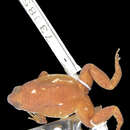Description
provided by AmphibiaWeb articles
Austrochaperina novaebrittaniae was previously included within Sphenophryne mehelyi (Tyler, 1967) until described by Zweifel (2000) as its own species. A. novaebritanniae is a small species ranging from 19 mm SVL in males to 21 in females. The snout is bluntly rounded when viewed dorsally and rounded/slightly projecting when viewed laterally. The nostrils are laterally placed and slightly visible dorsally. The loreal region is flat and moderately sloped. Eyes are laterally placed, large, and have an eyelid width 75% of the interorbital space. Relative finger lengths are 3>2=4>1, with the first digit one-half the length of the second. Toes are unwebbed and have relative lengths of 4>3>5>2>1 with discs larger than those on fingers. Supratympanic fold is weak. A. novaebritanniae is an almost dark ground color with white spots/flecks. In preservative, ground color appears tan. Ventral surfaces are slightly paler with a uniform pattern of pale spots.
Tyler, M. J. (1967). ''Microhylid frogs of New Britain.'' Transactions of the Royal Society of South Australia, 91, 187-190.
Distribution and Habitat
provided by AmphibiaWeb articles
The only known localities for this species are at the northern end of New Britain.
Life History, Abundance, Activity, and Special Behaviors
provided by AmphibiaWeb articles
May be in danger; Tyler (1967) found this species along with many others in high density under logs and other hiding places due to recent clearing of primary rainforest. Habitat in danger.
Austrochaperina novaebritanniae: Brief Summary
provided by wikipedia EN
Austrochaperina novaebritanniae is a species of frog in the family Microhylidae. It is endemic to the island of New Britain, Papua New Guinea. It is restricted to the northeastern part of the island where it occurs in lowland rainforests at elevations of 350–1,000 m (1,150–3,280 ft) above sea level. It has also been found in a recently cleared rainforest. It is threatened by the logging of lowland forest but can be locally abundant.
- license
- cc-by-sa-3.0
- copyright
- Wikipedia authors and editors

